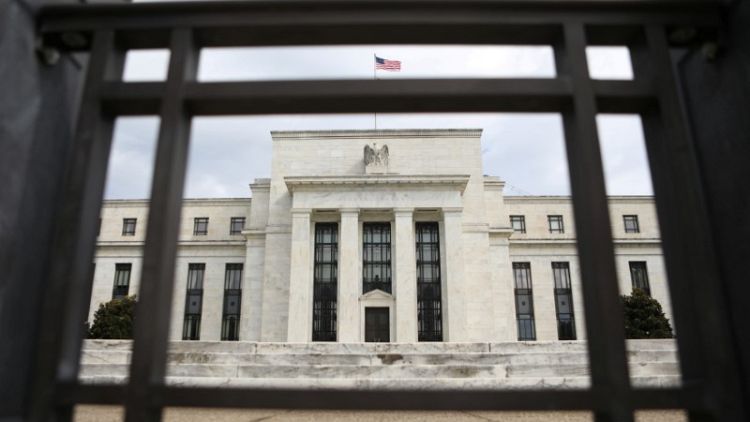By Karen Brettell
(Reuters) - The U.S. Treasury market has diverged from the Federal Reserve in painting a bleak picture of future U.S. economic growth and inflation, but the central bank looks unlikely to bend to the market's will anytime soon barring a notable turn for the worse.
Concerns about the impact of the U.S.-China trade war on global growth, tensions between Italy and the European Union, and the lack of agreement over how Britain will exit the European Union helped send benchmark U.S. Treasury yields to their lowest levels since September 2017 this week.
The yield curve between three-month bills and 10-year notes also moved further into negative territory. The inversion - when the yield on short-term maturities tops the yields on longer-dated ones - if it persists, is seen as a reliable indicator that a recession is likely in one-to-two years.
Other markets including stocks and corporate bonds, however, are not painting as negative a picture as are Treasuries, despite a recent uptick in volatility. Corporate bond yields have in fact fallen this month even as credit spreads widened.
“If both rates and credit were pointing the same way they would be much more prone to have the market driving Fed action, but this discrepancy means I don’t think the Fed will get bullied into anything,” said Michael Cloherty, head of U.S. rates strategy at RBC Capital Markets in New York.
With the drop in yields, interest rate futures traders increased their expectations of a rate cut to a better than 50-50 chance at the Fed’s September meeting, and they see more than an 80% chance of at least one cut by December, according to the CME Group’s FedWatch Tool.
But this also is not as reliable an indicator of Fed action as shorter-dated expectations, which show the Fed, which will also hold policy meetings in June and July, remaining on hold in the near-term.
“We’ve fully priced that first ease not until late this year, and that far out the market is not a great predictor to what the Fed will do,” Cloherty said.
While the Fed monitors the bond markets for signals on the economy, some analysts see the U.S. central bank as unlikely to cut rates without new economic concerns.
“They don’t have to cut because bond yields fall. They are going to cut because inflation underperforms, they are going to cut because we see something else on the global risk horizon that the Fed decides it’s time to respond to,” said Ian Lyngen, head of U.S. rates strategy at BMO Capital Markets in New York.
So far senior policymakers at the Fed have shown few signs that they ready to cut rates.
The Fed Board of Governors vice chair, Richard Clarida, said on Thursday that the U.S. economy is in "a very good place" and is as close to the Fed's goals of maximum employment and stable prices as it has been in 20 years.
The bond market move may prove to be prescient, however, if it is followed by further drops in inflation, worsening trade relations or other factors that could slow the economy, as some expect.
“The bond market is conveying a message that there is some event that could occur or is going to occur that the other markets aren’t necessarily looking at,” said Tom di Galoma, a managing director at Seaport Global Holdings in New York.
For a graphic on 'One signal to watch for a Fed rate cut', click: https://tmsnrt.rs/2Kfkmny
With two-year yields at 2.08% and now 30 basis points below the fed funds rate, the notes are approaching ratios that in the past have been followed by a rate reduction.
On average the U.S. central bank has cut rates when two-year yields fall to 78% of the fed funds rate, Citigroup analysts said in a recent report. In 2007, for instance, the ratio dropped below that threshold in late August, about three weeks before the Fed delivered the first of a barrage of rate cuts aimed at combating the then-unfolding financial crisis.
The current ratio is around 87%, and by this measure a drop in two-year yields to the 1.95% area could prompt action by the Fed.
Given the historically low level of rates, that ratio is likely a better indicator than the absolute difference in basis points between the two rates, Citigroup said.
For a graphic on 'How close is the Fed to a rate cut?', click: https://tmsnrt.rs/2WwPjdr
(Reporting by Karen Brettell; Editing by Dan Burns and Leslie Adler)



